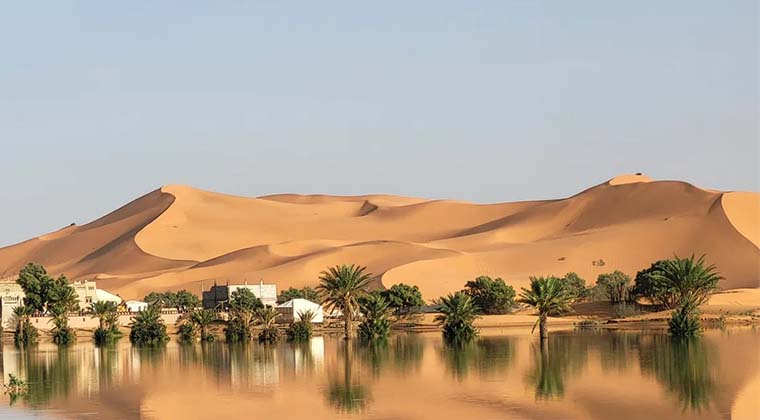The Sahara Desert, spanning an area of 9.2 million square kilometers across North Africa, is the largest hot desert in the world. A desert is defined by its extremely low rainfall, with typical annual precipitation under 250 millimeters. The Sahara stretches across several countries, including Algeria, Chad, Egypt, Eritrea, Libya, Mali, Mauritania, Niger, Sudan, Tunisia, and Morocco.
Recently, the Sahara Desert in Morocco drew global attention when a rare heavy rainfall caused parts of the desert to flood. This unprecedented rainfall created large pools of blue water between sand dunes, a phenomenon rarely seen in such arid regions. The rain, which had not been seen in decades, fell within just a few days, significantly exceeding the normal annual rainfall of the region.
Typically, the Sahara is known for its dryness, receiving minimal rainfall even in the winter. However, this unusual event saw over 250 millimeters of rain in just two days, which was more than the region’s typical yearly precipitation. In one village in Morocco, TagoUnit, over 100 millimeters of rain fell in just 24 hours, which was described as a “flash rainstorm.”
Historically, areas like Sagora and Tata in the Sahara were home to ancient lakes, but these dried up over the past 50 years. The recent rains caused the ancient lakebeds to fill with water, which was observed even from space by NASA’s Earth observation satellites.
Meteorologists describe such heavy rainfall in desert areas as “tropical storms,” which are becoming more frequent due to climate change. These changes, marked by increased humidity and the formation of storms in desert areas, are a result of a shifting climate system.
While this rain was a blessing for some communities in Morocco, filling underground aquifers and providing water for agriculture, it also caused destruction. Flash floods wiped out crops, and the intense rainfall led to the loss of lives as water surged through sand dunes and valleys. The Moroccan government reported that at least 20 people lost their lives due to the storm.
Experts are now linking such unusual weather events to the increase in global temperatures, which are primarily caused by human activities, including the burning of fossil fuels. The combustion of coal, oil, and natural gas, along with the release of greenhouse gases into the atmosphere, is accelerating the warming of the planet, leading to extreme weather events like heavy rain in deserts, wildfires, and the melting of glaciers.
In conclusion, the heavy rainfall in the Sahara is part of a larger trend of extreme weather patterns resulting from global warming. While it provided temporary relief in some areas, the long-term effects of climate change could lead to more frequent and severe weather events.
-Lankadeepa

